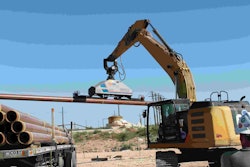As Miami was hammered by tropical storm force winds and the occasional hurricane force gust generated by Hurricane Irma, the booms of three tower cranes in the city came down Sunday.
No injures were reported in either incident and, according to a report from the Miami Herald, all three booms stayed attached to the towers of their cranes and did not fall to the street.
Though Irma’s course shifted far enough west Saturday night that the city did not take a direct hit from the storm, Miami officials warned late last week that the 20 to 25 tower cranes on construction jobsites throughout the city would not be able to withstand the up to 185 mile per hour winds that Hurricane Irma, then a Category 5 storm, was expected to bring.
The booms of tower cranes are designed to spin in heavy winds, and can typically withstand wind speeds up to 145 mph. According to the Weather Channel, Miami had seen reports of gusts above 130 mph with several reports in the 100 mph range. (Two hours to Miami’s northwest in Naples, where Irma’s eye made a second landfall, sustained winds of 95 mph were reported with gusts up to 140+ mph.)
According to the Miami Herald report, the boom of the first crane, located at an under-construction apartment building at 300 Biscayne Blvd. in downtown, “bent and collapsed” around 10:30 a.m. Sunday. Firefighters watched the crane, whose boom “is still connected to the tower of the crane by a cable,” fall.
Irma spinning cranes pic.twitter.com/TuMrgwpSBi
— Yossi Kudan יוסי (@Yossikudan) September 10, 2017
The second crane’s boom came down “hours later” and 2 miles north in the city’s Edgewater neighborhood, the Herald reports. The crane is on the jobsite of a condo being built at 600 NE 30th Ter.
ALERT: Second crane collapses in Miami, dangling above unfinished tower on NE 30th Terr. #Irma https://t.co/okaKIkuNVV
— Lincoln O'Barry (@LincolnOBarry) September 10, 2017
The third crane accident occurred at 5 p.m. Sunday in Fort Lauderdale, 30 miles from downtown Miami. Police were unable to reach the jobsite due to downed trees, the Herald reported.
City officials have instructed developers to “remove the [damaged] ]cranes and secure the sites after the hurricane passes,” according to the report.
The cranes could not be removed before the storm hit the area because they take weeks to disassemble. The booms on the cranes were allowed to remain loose, as locking them down would have created greater wind resistance and more of a risk.
In light of the two collapses, the Herald reports that Miami Mayor Tomás Regalado “said the city should consider stricter codes for cranes, even if it came at the expense of building projects that generate revenue for the city.”
“It’s development in the future versus tropical storms or hurricanes,” Regalado told the paper. “We just can not gamble on the wind.”
As of publishing time Sunday, Irma had left more than 1.8 million homes and businesses without power.












